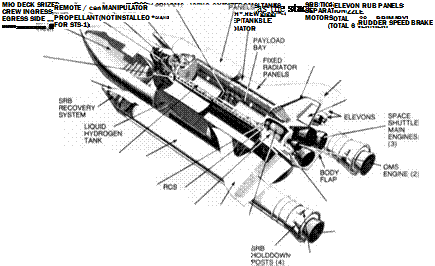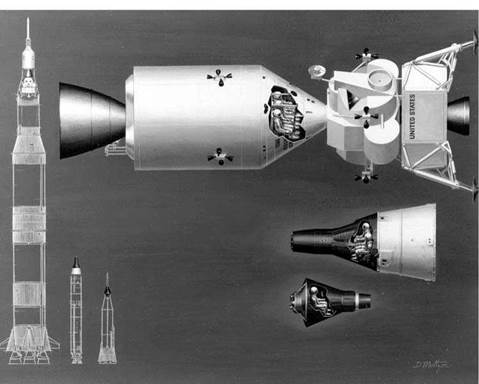American orbital launchers
The Atlas ICBM was used to launch four manned Mercury missions in 1962-3, while the Titan II ICBM launched ten Gemini crews between 1965-6. A modified Titan II would have been used to fly the manned DynaSoar military space plane in the mid – 1960s, but this was cancelled in 1963 and replaced by the Gemini-based military Manned Orbital Laboratory. This was due to be launched on a Titan IIIM starting in 1966 but was also cancelled (in 1969), with some of its astronauts transferring to NASA.
The Atlas D intercontinental ballistic missile (ICBM) had a thrust of 166,470 kg (367,066 lb) from two Rocketdyne LR89 engines – which were burnt out and separated at about T + 2 min 14 sec – and an LR105 central sustainer engine. These were powered by liquid oxygen and kerosene. The Atlas was stabilised at lift-off by two powerful vernier engines. The Mercury-Atlas combination was 29 m (95 ft) high. The Atlas booster for the fifth manned mission was the first of a new model to be used for Mercury and was static test-fired on the pad because the US Air Force was concerned about turbo-pump failures that had occurred on some military ICBM launches. Atlas 113D would also ascend on ignition, rather than remaining on the pad for the previously prescribed two-second hold down period.
The Gemini Launch Vehicle (GLV) was a modified ICBM. Its twin first-stage LR-87 engines burned nitrogen tetroxide and hydrazine hypergolic propellants which ignited spontaneously on contact. The first-stage engines had a thrust of 195,046 kg (430,076 lb). The second stage, with a smaller LR-91 engine, had a thrust of 45,359 kg (100,017 lb). First-stage cut-off came at T + 2 min 30 sec, with a “fire in the hole’’ second-stage ignition following immediately. Orbit was achieved in 5 min 30 sec after launch. The launch vehicle was 3.04m (10 ft) in diameter and with Gemini on top, was 33.22m (109ft) tall.
The Saturn family of launch vehicles was developed for civilian space launches by a team led by Werner von Braun. The series built upon the successes and proven hardware of its early variants (Saturn 1 and 1B) before the huge Saturn V was used to send American astronauts to the Moon. Other variants were proposed but none were funded or built. Following a series of unmanned launches, the Saturn 1 manned missions were cancelled as unnecessary. After unmanned test flights, the Saturn 1B
|
Comparison of the US Mercury, Gemini and Apollo space capsules, and their launchers |
launched one Apollo crew on a test flight in 1968, three Skylab space station crews in 1973-4 and the US part of the Apollo-Soyuz Test Program in 1975. Just two unmanned test flights were flown before the Saturn V carried a crew aloft for the first time. Apollo 8 and 10-17 launched their crews to the Moon in 1968-72, while Apollo 9 launched to Earth orbit as planned.
The Saturn 1B launch vehicle, with the launch escape system on top of the Command Module, was 74.37 m (244 ft) tall. The launch escape system comprised a 10m (33ft) high tower with a 66,675kg (147,018lb) thrust solid propellant motor, which could be used on the pad or during the first 100 seconds of launch. When ejected, it pulled away a conical blast shield from the Command Module, exposing the latter’s five windows. The first stage of the Saturn 1B comprised eight H1 engines, developing a thrust of 743,899 kg (1,640,297 lb) and burning the RP1 and liquid oxygen propellants for the first 150 seconds. The second stage was the S-IVB cryogenic liquid oxygen/ liquid hydrogen stage that would also form the third stage of the Saturn V booster. The S-IVB was powered by the J2,102,059 kg (225,040 lb) thrust engine with a burn time of 450 seconds. This engine could be restarted. The Saturn S-IVB also included the allimportant Instrument Unit, the vehicle’s guidance and performance system. The
Saturn 1B was also the first manned launch vehicle used that was not a converted ballistic missile.
The Saturn V launch vehicle was 110.64 m (363 ft) high from the base of the F1 engines to the tip of the launch escape system tower. The first stage, called the S-1C, had five F1 engines developing a thrust of 3,442,801kg (7,591,376 lb) and burning liquid oxygen and RP1 propellants at a rate of 15 tonnes a second. The second stage, the S-11, also had five engines, called J2, with a thrust of 498,956kg (1,100,198 lb). The third stage was the S-IVB from the Saturn 1B launch vehicle. The whole vehicle weighed 2,903,020 kg (6,401,159 lb) at lift-off. The third stage was used for the Trans-Lunar Injection (TLI) burn to take the spacecraft out of Earth orbit and towards the Moon. The last Saturn V launch was a two-stage variant that carried the unmanned Saturn Workshop (Skylab) – itself a modified former S-IVB stage – in 1973. The earlier and larger Nova launch vehicle was abandoned in favour of the Saturn class of vehicles, which would be developed much quicker.
 |
The Space Shuttle flew its first mission in 1981 and will be retired in 2010, although the programme may be extended if there are any further delays to the completion of the International Space Station. The “Space Shuttle” is a combination of boosters, fuel tank and orbital vehicle, often termed “the stack”. The orbiter is the manned portion of the vehicle and there have been six orbiters built: OV-101 (Enterprise) was used for
|
With the Solid Rocket Boosters lit, the Shuttle is committed to launch |
atmospheric and ground tests; OV-102 (Columbia 1981-2003) was the first to launch to space and was lost in the STS-107 re-entry accident; OV-099 (Challenger 19831986) was a former structural test article and was lost in the STS 51-L launch accident; OV-103 (Discovery) is the oldest remaining vehicle and has been in service since 1984; OV-104 (Atlantis) has been used since 1985; and OV-105 (Endeavour) was built as a replacement for Challenger and was introduced in 1992.
The Space Shuttle orbiter Enterprise, which was to have been refurbished for space flight later, made five approach and landing atmospheric glide flights over Edwards Air Force Base in 1977, being air-launched from the back of a Boeing 747. Three flights were piloted by NASA astronauts Fred Haise and Gordon Fullerton and the other two by Joe Engle and Richard Truly. The longest glide flight, ALT 3, lasted 5 min 34 sec. Columbia was the first space flight-worthy orbiter and weighed 99,454 kg (219,296 lb) at orbital insertion. The orbiter measured 37.24 m (122 ft) long, with a wingspan of 23.79 m (78 ft). Three liquid hydrogen/liquid oxygen main engines, with a maximum thrust rating of 100 per cent, 170,098 kg (375,066 lb) each at sea level, took the orbiter into an initial orbit, which was then augmented by firing the Orbital Manoeuvring System (OMS) engines. These were powered by nitrogen tetroxide and UDMH, which also powered the reaction control thrusters. Power was provided by a liquid oxygen/ liquid hydrogen fuel cell system. A Thermal Protection System (TPS) heat shield tile system, comprising over 35,000 tiles, covered the orbiter to protect it from re-entry temperatures of between 370 and 1,260°C. A 756,453 kg (1,667,979lb), 47m (154 ft) long, 3.7 m (12 ft) wide External Tank (ET), painted white on the first two missions, held the SSME liquid oxygen and liquid hydrogen. Attached to it were two 45.46 m (149 ft) long, 3.7 m (12 ft) wide Solid Rocket Boosters (SRB), weighing 586,502 kg (1,293,237lb). Tail to nose, the Shuttle stack measured 56.144m (184ft) tall. The orbiter, an unpowered glider, had conventional flaps, rudder and ailerons for control in the atmosphere. Columbia’s STS-1 landing speed was 344kph (214mph). Improvements were made to the Shuttle fleet all the time. For example, Challenger was equipped with SRBs with an uprated thrust of 1,469,200 kg (3,239,586 lb) on its first mission, as well as main engines which were throttled up to 104 per cent for the first time. It also carried a new lighter weight external tank. Much of the areas covered with Low Temperature Surface Insulation tiles on Columbia were covered by lighter blankets of Advanced Flexible Reusable Surface Insulation on Challenger.












